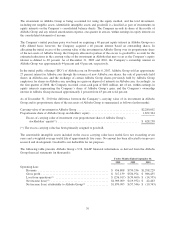Yahoo 2010 Annual Report Download - page 86
Download and view the complete annual report
Please find page 86 of the 2010 Yahoo annual report below. You can navigate through the pages in the report by either clicking on the pages listed below, or by using the keyword search tool below to find specific information within the annual report.
Investments in both fixed rate and floating rate interest earning instruments carry a degree of interest rate risk.
Fixed rate securities may have their fair market value adversely impacted due to a rise in interest rates, while
floating rate securities may produce less income than expected if interest rates fall. Fixed income securities may
have their fair market value adversely impacted due to a deterioration of the credit quality of the issuer. The
longer the term of the securities, the more susceptible they are to changes in market rates. Investments are
reviewed periodically to identify possible other-than-temporary impairment. The Company has no current
requirement or intent to sell these securities. The Company expects to recover up to (or beyond) the initial cost of
investment for securities held.
The FASB’s authoritative guidance on fair value measurements establishes a framework for measuring fair value
and requires disclosures about fair value measurements by establishing a hierarchy that prioritizes the inputs to
valuation techniques used to measure fair value. The hierarchy gives the highest priority to unadjusted quoted
prices in active markets for identical assets or liabilities (Level 1 measurements) and lowest priority to
unobservable inputs (Level 3 measurements). The three levels of the fair value hierarchy are described below:
Basis of Fair Value Measurement
Level 1 Observable inputs that reflect quoted prices (unadjusted) for identical assets or liabilities in active
markets.
Level 2 Inputs reflect quoted prices for identical assets or liabilities in markets that are not active; quoted prices
for similar assets or liabilities in active markets; inputs other than quoted prices that are observable for
the asset or the liability; or inputs that are derived principally from or corroborated by observable
market data by correlation or other means.
Level 3 Unobservable inputs reflecting the Company’s own assumptions incorporated in valuation techniques
used to determine fair value. These assumptions are required to be consistent with market participant
assumptions that are reasonably available.
The following table sets forth the financial assets, measured at fair value, by level within the fair value hierarchy
as of December 31, 2009 (in thousands):
Fair Value Measurements at Reporting Date Using
Assets Level 1 Level 2 Total
Money market funds(1) ................................... $364,602 $ — $ 364,602
Available-for-sale securities:
Government and agency securities(1) ..................... — 1,938,608 1,938,608
Municipal bonds(1) ................................... — 470,031 470,031
Commercial paper and bank certificates of deposit(1) ........ — 445,786 445,786
Corporate debt securities(1) ............................ — 641,104 641,104
Available-for-sale securities at fair value ............. $364,602 $3,495,529 $3,860,131
Corporate equity securities(2) .......................... 2,597 — 2,597
Total assets at fair value .......................... $367,199 $3,495,529 $3,862,728
(1) The money market funds, government and agency securities, municipal bonds, commercial paper and bank
certificates of deposit, and corporate debt securities are classified as part of either cash and cash equivalents
or investments in marketable debt securities in the consolidated balance sheet.
(2) The corporate equity securities are classified as part of the other long-term assets in the consolidated balance
sheet.
The amount of cash and cash equivalents as of December 31, 2009 includes $658 million in cash deposited with
commercial banks, of which $205 million are time deposits.
84
























